|
Use
of the Hip in Tang Soo Do
Master C. Terrigno
- 6th Dan
Editor - Tang Soo Do World
As
most Tang Soo Do practitioners know, the extensive
use of the hip is fundamental to our art and is its
most distinguishing feature - its "signature" which
sets us apart from other martial arts systems in
terms of how we move. At first glance, the correct
use of the hip may seem like a simple principle but
in reality it is a difficult one for both Gups and
Dans alike to internalize and execute properly.
Our late Great Grandmaster Hwang Kee devoted a
considerable amount of space in his textbook to the
"scientific use of the hip" in Tang Soo Do, so it is
imperative that practitioners take the time to fully
understand it and apply it early on in their
training so as not to create bad habits that will
later be difficult (and time consuming) to correct.
From personal experience I know the extra work it
takes to "un-learn" acquired muscle memory, although
my situation was not due to having formed bad habits
per se, but from having studied Japanese Karate for
six years prior to Tang Soo Do. Japanese karate
techniques are more linear and direct, with less hip
rotation compared to our art. Consequently, I had to
work extremely hard at overriding my instinctual
movements and replace them with the more circular
motions that Tang Soo Do is known for. I can still
hear my original Instructors, especially Master
Young Ki Hong admonishing me, always with the same
statement - Hu Ri, Hu Ri. And after a little while
he would just look me in the eye and with his ever
present smile simply say - more practice! Yes Sir, I
would respond. That was over 26 years ago, and I'm
still working at it.
The challenge for students with no prior training is
to overcome their natural tendency to use one part
or area of the body more than or in opposition to
the other(s). Men, because of their physical build
and strength are prone to predominately using the
upper body while at the same time applying too much
power, literally throwing themselves head first into
the movements.
To correct this, your Instructors have no doubt
urged you to "keep your back
straight", "move from your center or abdomen (Dan
Jun)", "rotate your hips (Hu Ri)", and
use "more trunk
twist". Easier said than done in many cases,
especially in the heat of training when there is no
time to stop and think, and maybe that is the point -
there is no time to think about a technique when
you're in the middle of it. The "thinking" should be
done when we're off the training floor. Consider it
the planning or research phase of your training.
|
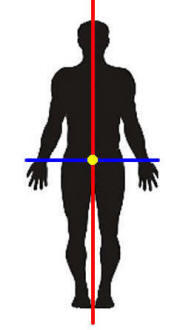 |
So to
help put these terms into visual context, consider the drawing at
right. The Hu Ri, or hip, is the blue horizontal line and the red
line is our central axis which keeps us in correct vertical
alignment. A trunk twist then is simply the blue line rotating from
one side to the other of the red line.
Where both lines intersect is the Dan Jun (yellow dot), the central
balancing point about 3" below the navel. This is where our energy
resides and movement is initiated from.
When all these considerations are met and the correct amount of
power is added we are said to be in balance (Choong Shim). Movement
will then be fluid and effortless.
With the benefit of this illustration in hand, there are three
concepts to explore to help achieve fluid and powerful motion.
●
Offensive Hip
●
Defensive Hip
●
and
Pull rather than Push
Offensive Hip
This is most often employed in Tang Soo Do attacks, although there are
some attacks where a defensive hip is used. For purposes of illustration
we will focus on the middle punch. Offensive Hip is characterized by
opening up of the hip, holding it back and then releasing it at the
moment of impact (the final step). You will note in the photos below
that the vertical alignment mentioned earlier is maintained. There is no
leaning forward with the upper body.
(Note: Because I am using snapshots rather than video, Figure
3 below would seem to be an actual step, however it is not. It is the
position your body would be in if we froze the video just before the
final hip rotation when the punch is released. In reality, the foot has
not even landed yet. The landing, hip rotation and punch all happen at
the same time as in Figure 4. The photo is meant to show that the punch
has not yet moved forward - a mistake commonly made by beginners where
their punch precedes the step.)
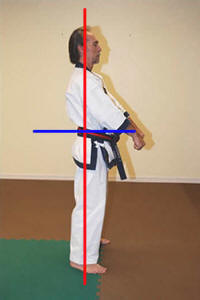 |
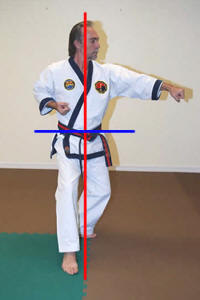 |
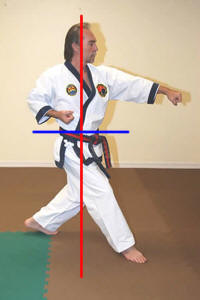 |
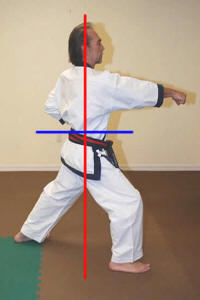 |
|
Figure 1 |
Figure 2 |
Figure 3 |
Figure 4 |
Defensive Hip
With Defensive Hip you have a contraction, or closing in of the hips. It
is a defensive posture where we also present the smallest target to the
attacker. Figure 3 once again highlights the fact that the hip has not
yet turned and the blocking hand has not yet moved. As above, this all
happens in Figure 4.
 |
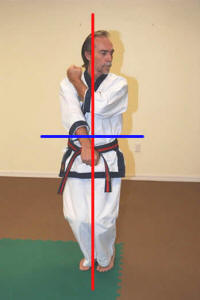 |
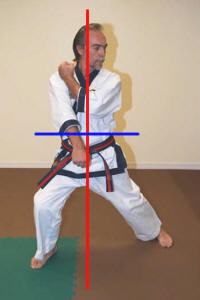 |
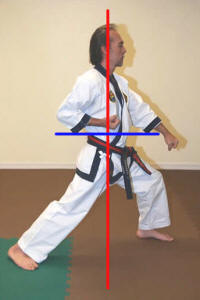 |
|
Figure 1 |
Figure 2 |
Figure 3 |
Figure 4 |
Pull rather than
Push
This concept might be a bit abstract and difficult for some to grasp
because it is more mental than physical, and it relates to the Dan Jun
specifically.
When you push something you have its mass and weight in front of you. By
its very nature it literally and figuratively gets in your way. As a
result, students tend to overcompensate by applying more power than
necessary to drive their techniques home.
An analogy that my students are used to hearing from me is this. A
rear-wheel drive car driven in the snow has a greater tendency to
fishtail and lose control because it is pushing the mass in front of the
rear wheels, and the more power you give it, the worse it gets. With a
front-wheel drive car you are being pulled and because the mass is
behind you it simply follows where you steer. In addition, pushing is
more awkward than pulling. Try pushing something heavy across any
surface and then pull it and you'll see what I mean. It also takes less
energy to pull. You will also find that this concept is not limited to
just martial arts activities - a golfer pulls not pushes the club
through to the golf ball; a batter pulls the bat to the baseball, and a
fly fisherman pulls (whips) his line to his target spot in the stream).
To implement this type of motion, whether you're in Offensive or
Defensive Hip, think of a string tied to your Dan Jun point and that
there is an outside force (not your own) that is pulling you forward.
Imagine now that forceful pull suddenly stopping (as in hitting the
brakes on your car). What happens next is "inertia" - everything wants
to keep moving forward until it comes to a snapping halt. This is what
happens to your punch or block. When done correctly, it goes by itself.
You "become" the punch or block. The greater the pull the more power in
the technique at the end. Of course you must again remember that what
prevents your whole body from falling forward is keeping it aligned with
the vertical axis.
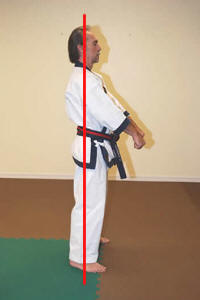 |
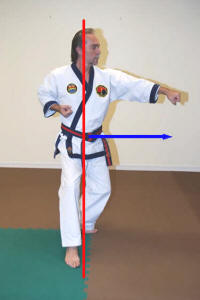 |
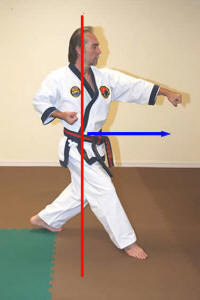 |
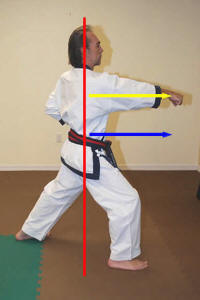 |
|
Figure 1 |
Figure 2 |
Figure 3 |
Figure 4 |
As a further aid in
your practice, try this simple exercise. First walk across the room as
you normally would and try to sense where your propulsion is coming
from. Next, switch your awareness and visualize a string tied to your
Dan Jun which is being pulled by someone else, and with your back
straight, just go with it. It will probably be very awkward at first but
with practice you will begin to feel as if you're gliding along as
opposed to being pushed across the floor.
Like everything else we do in our training, the benefits to
understanding and putting these concepts to use spill over (in a
positive way) to other tasks we perform in our daily lives. These may even
change how you move entirely.
I hope you find this useful in your continued studies. |